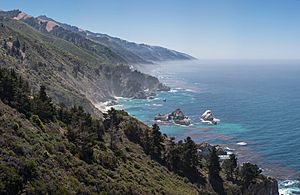Central Coast (California) facts for kids
Quick facts for kids
Central Coast
|
|
|---|---|
|
Region of California
|
|
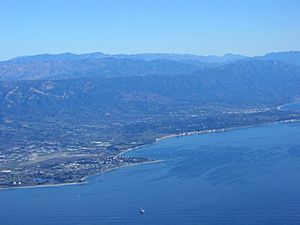
South Coast of Santa Barbara County
|
|
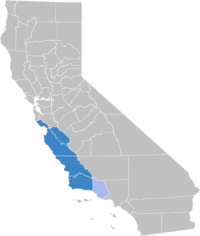
Location of the Central Coast in California
(The lighter shaded area includes South Coast counties that are included in some definitions) |
|
| Country | United States |
| State | California |
| Population | 2,249,558 (All 6 counties combined) |

The Central Coast is a special part of California. It stretches along the Pacific Ocean between Point Mugu and Monterey Bay. This area is northwest of Los Angeles and south of the San Francisco Bay Area. It includes the beautiful, wild coastline known as Big Sur.
Six counties make up the Central Coast, from south to north:
- Ventura County
- Santa Barbara County
- San Luis Obispo County
- Monterey County
- San Benito County
- Santa Cruz County
This region is also home to the Central Coast American Viticultural Area, which is famous for its wines. The true middle point of California's coast is actually north of Santa Cruz, near Año Nuevo State Park.
Contents
A Look Back: History of the Central Coast
The Central Coast has a long and rich history. Native American groups like the Chumash, Ohlone, Esselen, and Salinan lived here for at least 10,000 years. Many of these communities lived by the ocean. They used resources from the sea and lived near rivers flowing into the Pacific. For example, large communities thrived near Morro Creek and Los Osos Creek.
In 1542, explorer Juan Rodríguez Cabrillo sailed north along the coast. He landed in Santa Barbara County, marking the first European contact.
Missions and Their Impact
When the Spanish set up missions starting in 1770, they brought big changes. Native people were baptized and asked to work at these missions. Unfortunately, they were exposed to new diseases like smallpox and measles. The native people had no protection against these illnesses, which greatly reduced their population. Many who survived later blended with Spanish and Mexican ranchers.
Under Spanish law, native people were technically free. However, they could be forced to work without pay. Soldiers helped move Native Americans living near the missions to the mission grounds. There, they were trained as farmers, shepherds, and craftspeople. Sadly, many faced sickness, hunger, and hard labor.
What Makes the Central Coast Special?
The Central Coast is well-known for two main things: farming and tourism.
Farming in the Central Coast
Farmers here grow many important crops. These include wine grapes, lettuce, strawberries, and artichokes. The Salinas Valley is one of the most fertile farming areas in the entire United States.
Fun Places to Visit
The Central Coast offers many exciting places for visitors.
- Cannery Row in Monterey is a historic waterfront area.
- The Monterey Bay Aquarium is a world-famous marine life center.
- Carmel-by-the-Sea has beautiful theaters, art galleries, and white sand beaches.
- Golf fans love the courses in Pebble Beach and the Monterey Peninsula.
- The wild coast of Big Sur is famous for its dramatic cliffs and ocean views.
- Hearst Castle in San Simeon is a grand historic estate.
- Further south, you can see Morro Rock and visit the port city of Morro Bay.
- Near Morro Bay is San Luis Obispo, a lively college town.
- The Santa Ynez Valley is known as "Hollywood's Backyard." It celebrates movies and filmmakers from the region.
The Central Coast is not very crowded. The largest city is Oxnard in Ventura County.
Learning and Education
The Central Coast has several great universities.
- The University of California, Santa Barbara is in the southern part of the region.
- The University of California, Santa Cruz is in the northern part.
- California State University, Monterey Bay opened in 1994. It uses buildings from a former military base called Fort Ord.
- California Polytechnic State University in San Luis Obispo was founded in 1901.
- California State University Channel Islands opened in Camarillo in 2002. It is one of the newest campuses in the California State University system.
Central Coast Population Facts
In 2020, the six counties of the Central Coast had an estimated population of over 2.3 million people.
Central Coast Counties by Population
| County |
FIPS code | County seat | Established | Formed from | Meaning of Name | Population | Area | Map |
|---|---|---|---|---|---|---|---|---|
| Ventura County | 111 | Ventura | 1872 | Santa Barbara | Named after the city of Ventura, which is short for San Buenaventura, meaning "St. Bonaventure" in Spanish. | 843,843 | 1,846 sq mi (4,781 km2) |
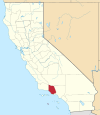 |
| Santa Barbara County | 083 | Santa Barbara | 1850 | Original | Named after the city of Santa Barbara, meaning "Saint Barbara" in Spanish. | 448,229 | 2,738 sq mi (7,091 km2) |
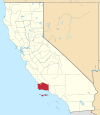 |
| Monterey County | 053 | Salinas | 1850 | Original | Named after Monterey Bay, which means "royal mountain" in Spanish. | 439,035 | 3,322 sq mi (8,604 km2) |
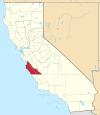 |
| San Luis Obispo County | 079 | San Luis Obispo | 1850 | Original | Named after the city of San Luis Obispo, meaning "Saint Louis, the Bishop" in Spanish. | 282,424 | 3,304 sq mi (8,557 km2) |
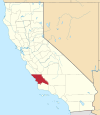 |
| Santa Cruz County | 087 | Santa Cruz | 1850 | Original | Named after the city of Santa Cruz, meaning "holy cross" in Spanish. | 270,861 | 446 sq mi (1,155 km2) |
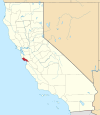 |
| San Benito County | 069 | Hollister | 1874 | Monterey | Named after the San Benito River and its valley, which was named after Saint Benedict in Spanish. | 64,209 | 1,389 sq mi (3,597 km2) |
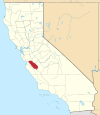 |
Major Cities in the Central Coast
Here are the cities in the Central Coast with populations over 20,000 as of 2020:
- Oxnard - 202,063
- Salinas - 163,542
- Thousand Oaks - 126,966
- Simi Valley - 126,356
- Ventura - 110,763
- Santa Maria - 109,707
- Santa Barbara - 88,665
- Camarillo - 70,741
- Santa Cruz - 62,956
- Watsonville - 52,590
- San Luis Obispo - 47,063
- Lompoc - 44,444
- Hollister - 41,678
- Moorpark - 36,284
- Goleta - 32,690
- Seaside - 32,366
- Paso Robles - 31,490
- Santa Paula - 30,657
- Monterey - 30,218
- Atascadero - 29,773
- Soledad - 24,925
- Marina - 22,359
- Port Hueneme - 21,954
Getting Around the Central Coast
Most people travel by car in the Central Coast. San Luis Obispo is famous for having America's first motel. This is because it's about halfway between Los Angeles and San Francisco.
Roads and Highways
The main highway is U.S. Route 101. It runs north and south, connecting Los Angeles to San Francisco through most Central Coast cities. State Route 1 is a smaller, very scenic road. It connects coastal towns like San Simeon, Morro Bay, and Big Sur.
Trains and Buses
Amtrak offers train service with the Coast Starlight and Pacific Surfliner routes. These trains use the Union Pacific Railroad Coast Line, which also carries freight. There are no huge airports, but Monterey, Santa Barbara, Santa Maria, and San Luis Obispo have smaller regional airports. Greyhound buses also serve most of the area.
Local bus services help people get around. Monterey-Salinas Transit (MST) operates buses throughout Monterey County. This includes areas as far south as Big Sur and King City. MST also connects to San Jose Diridon Station and downtown Santa Cruz. Santa Cruz Metro provides bus services within Santa Cruz County. It also connects to San Jose and San Jose State.



